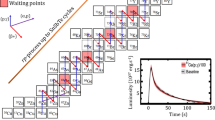Abstract
In this work, the X-PMSP program, a new user-friendly code for calculating the mass stopping power of elements for charged particles, is introduced with a few sample calculations for each charged particle. The mass stopping power calculations of X-PMSP program are compared with the other mass stopping power results in the literature. These results show that X-PMSP program calculations of mass stopping power for charged particles on elements are suitable. X-PMSP program also contributes to the literature, especially, in radioisotope production, because in addition to proton and alpha charged particles, the mass stopping power of He-3, deuteron, and triton charged particles can be calculated for 98 elements (Z < 98).






Similar content being viewed by others
References
Artun O (2017a) Investigation the production of Promethium-147 via particle accelerator. Indian J Phys 91(8):909–914
Artun O (2017b) Estimation of the production of medical Ac-225 on thorium material via proton accelerator. Appl Radiat Isot 127:166–172
Artun O (2018) Calculation of productions of PET radioisotopes via phenomenological level density models. Radiat Phys Chem 149:73–83
Attix FH (1986) Medical physics. University of Wisconsin Medical School Madison; Press: WILEY-VCH Verlag GmbH & Co KgaA, Wisconsin, p 505
Ditroi F, Tarkanyi F, Takacs S, Hermanne A (2016) Activation cross-sections of proton induced reactions on vanadium in the 37–65 MeV energy range. Nucl Instrum Methods B 381:16–28
Hassan HE, Qaim SM (2011) A critical survey of experimental cross section data, comparison with nuclear model calculations and estimation of production yields of 77Br and 77Kr in no carrier-added form via various nuclear processes. Nucl Instrum Methods B 269:1121–1129
Hassan KF, Qaim SM, Saleh ZA, Coenen HH (2006) 3He-particle-induced reactions on natSb for production of 124I. Appl Radiat Isot 64:409–413
Hermanne A, Rebeles RA, Tarkanyi F, Takacs S, Spahn I, Ignatyuk AV (2011) High yield production of the medical radioisotope 167Tm by the 167Er(d,2n)reaction. Appl Radiat Isot 69:475–481
Microsoft (2017) Visual studio. https://www.visualstudio.com/. Accessed 10 Apr 2017
NIST (2017) PSTAR and ASTAR databases for protons and helium ions. http://physics.nist.gov/PhysRefData/Star/Text/programs.html. Accessed 15 Apr 2017
Paul H, Schinner A (2003) Empirical stopping power tables for ions from 3Li to18Ar and from 0.001 to1000 MeV/nucleon in solids and gases. Atom Data Nucl Data Tables 85:377–452
Sternheimer RM, Berger MJ, Seltzer SM (1984) Density effect for the ionization loss of charged particles in various substances. Atom Data Nucl Data Tables 30(2):261–271
Tarkanyi F, Takacs S, Ditroi F, Hermanne A, Ignatyuk AV (2013) Activation cross sections of longer-lived radioisotopes of deuteron induced nuclear reactions on terbium up to 50 MeV. Nucl Instrum Methods B 316:183–191
Torresi D, Carbone D, Cavallaro M, Pietro AD, Fernández Garcia JP, Figuera P, Fisichella M, Lattuada M, Zadro M (2006) Measurement of the stopping power for 16O in 4He gas. Nucl Instrum Methods B 389:1–4
Tripathy SP, Mishra R, Dwivedi KK (2005) Stopping power measurements of 118 MeV 28Si in polycarbonate detectors. Rad Measur 40:255–258
Williamson CF, Boujot JP, Picard J (1966) Tables of range and stopping power of chemical elements for charged particles of energy 0.05 to 500 MeV, Rapport CEA-R 3042 Premier Ministre Commissariat A L’energie Atomique. France, p 382
Author information
Authors and Affiliations
Corresponding author
Rights and permissions
About this article
Cite this article
Artun, O. Estimation of Mass Stopping Power and Range via a New Computer Program X-PMSP. Iran J Sci Technol Trans Sci 43, 639–643 (2019). https://doi.org/10.1007/s40995-018-0572-2
Received:
Accepted:
Published:
Issue Date:
DOI: https://doi.org/10.1007/s40995-018-0572-2




